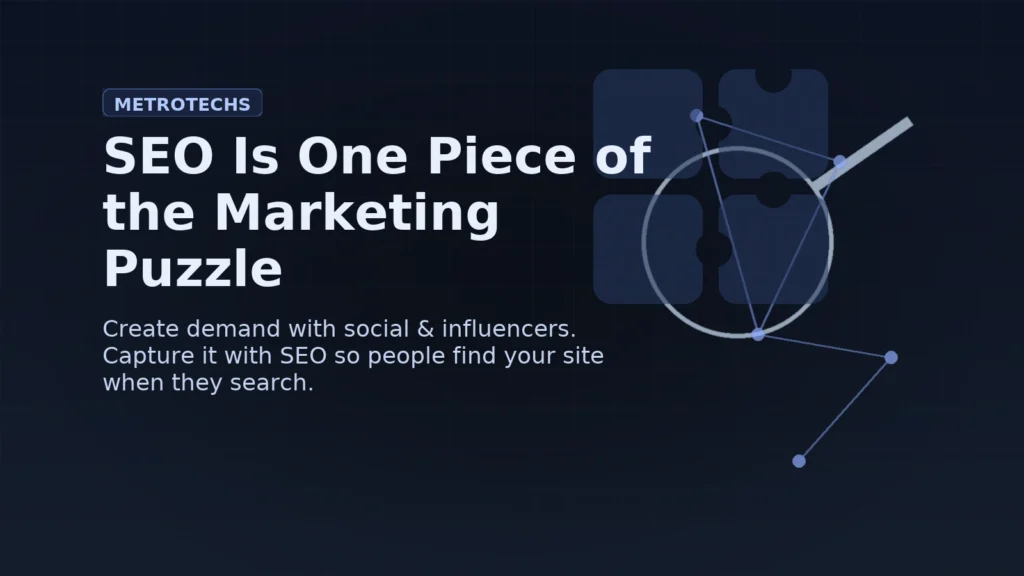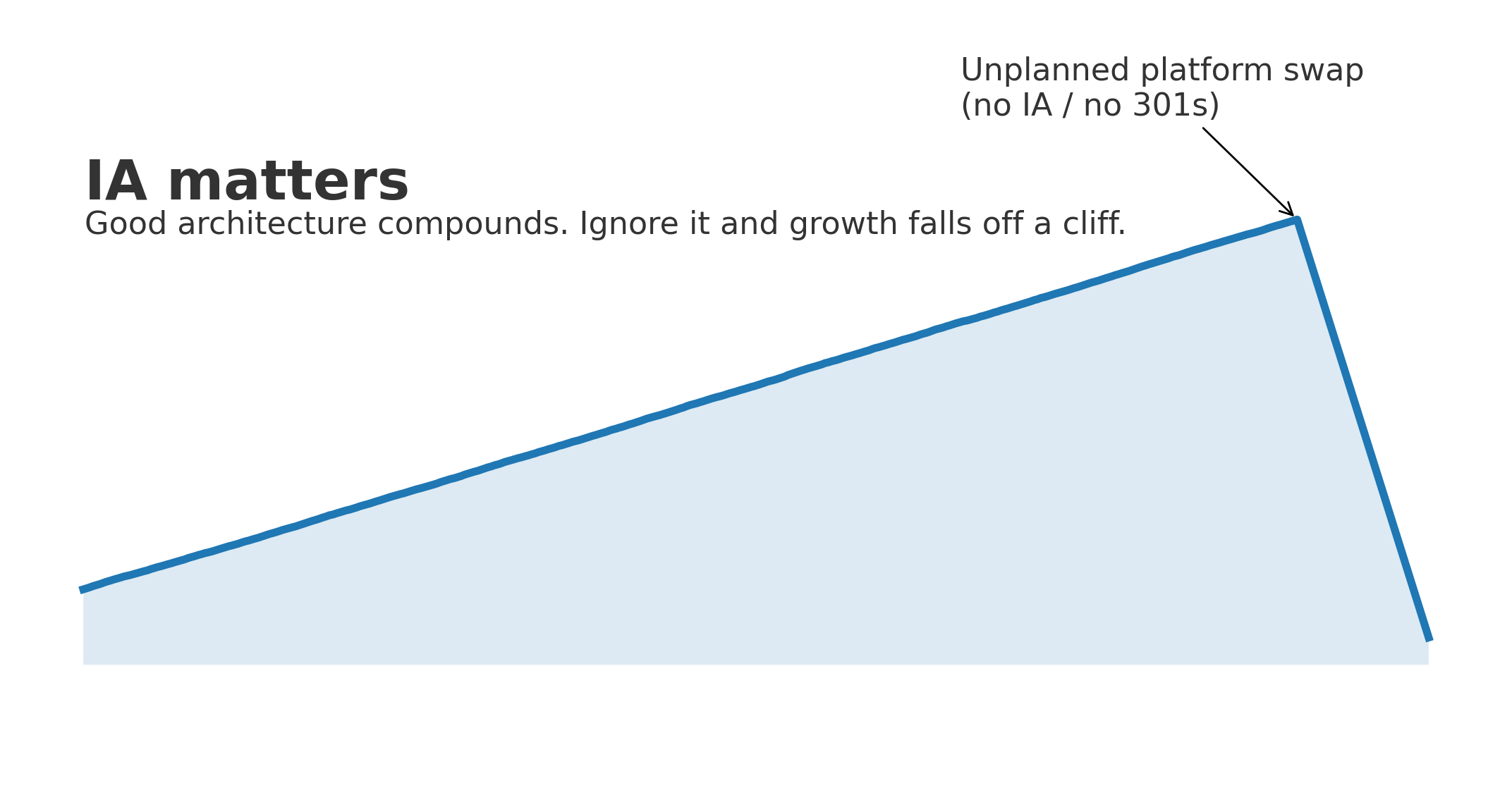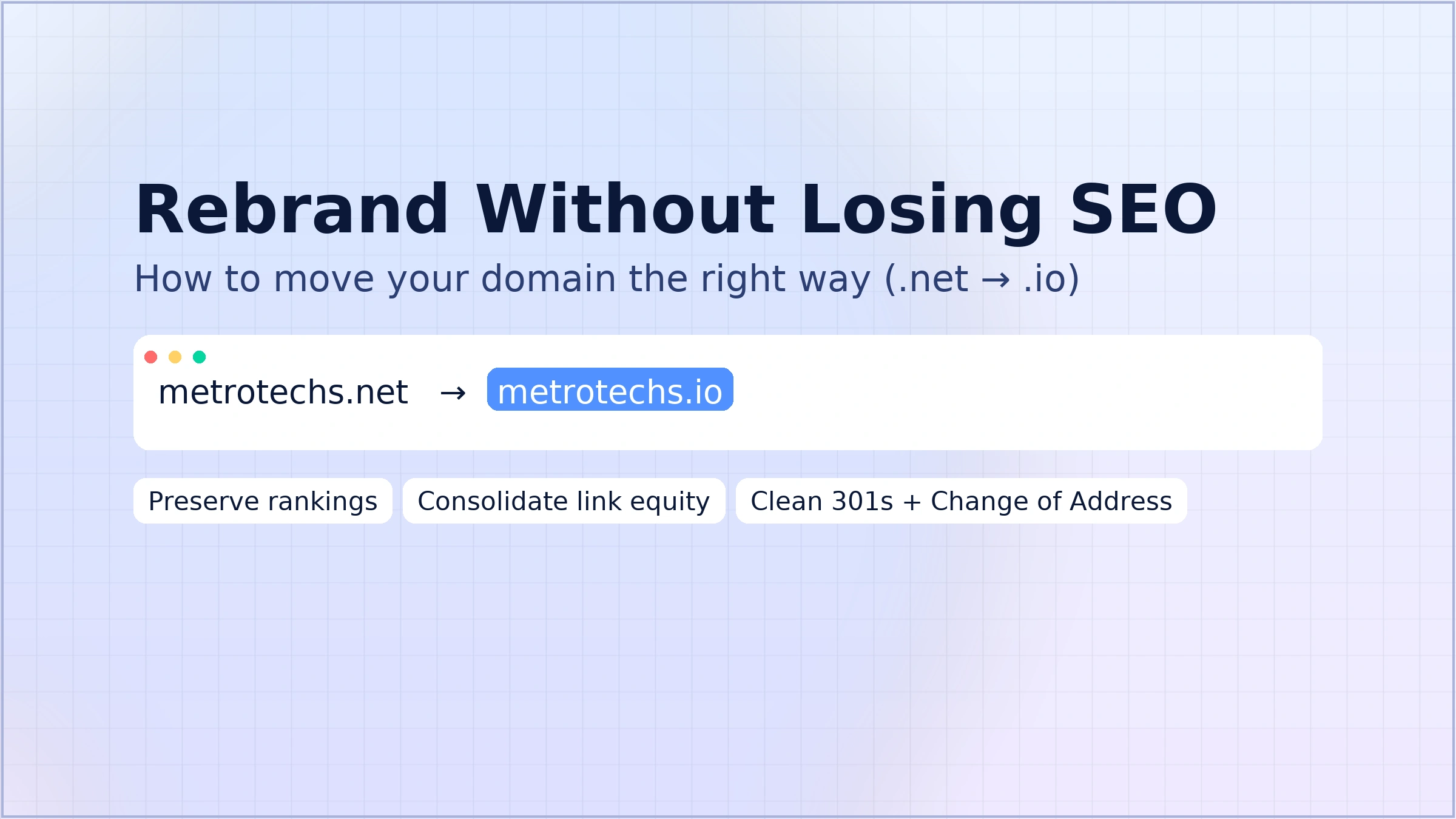TL;DR: SEO is demand capture, not demand creation. Social, influencers, PR, and ads spark interest and get people talking. SEO makes sure that when those people go searching, your site shows up—product pages, service pages, FAQs, all of it. If no one’s looking for you (brand, products, problems you solve), even perfect SEO won’t move the needle.
The Marketing Puzzle: Three Pieces That Work Together
Think of growth as a system with three interlocking pieces:
-
Demand Creation — Make people care.
Social media, influencer marketing, PR, partnerships, events, paid social, video. -
Demand Capture — Be easy to find when they look.
SEO, SEM, marketplaces, retail search, comparison sites. -
Demand Nurture — Stay in the conversation.
Email, SMS, community, retargeting, CRM, loyalty.
SEO lives in Demand Capture. It aligns your site with how people search—so you win clicks (and revenue) when intent exists.
What SEO Actually Does (and Doesn’t)
What SEO Does Well
-
Findability: Puts your site in front of people actively searching.
-
Trust & UX: Technical SEO improves speed, security, and structure—signals users and search engines love.
-
Compounding Returns: Strong architecture + content hubs + internal links create durable, compounding gains.
-
Lower CAC Over Time: Organic traffic reduces reliance on paid acquisition.
What SEO Won’t Do
-
It won’t create demand out of thin air.
If no one searches for your brand or category, there’s nothing to capture. -
It won’t out-shout culture.
If Reddit threads, creator reviews, and marketplaces own the conversation, you need to feed that ecosystem—then capture the searches it generates.
How Social & Influencers Supercharge SEO
Awareness activities increase:
-
Branded searches (“YourBrand binoculars”), which you should dominate.
-
Unlinked and linked mentions that grow authority.
-
User-generated content that fuels reviews, comparisons, and how-tos.
-
Click-through rates on your brand in SERPs (people click what they recognize).
Run creators and social to spark interest → People Google you → Your SEO ensures the right page ranks and converts.
A Simple Growth Model by Stage
New Brand (pre-awareness):
-
60% Demand Creation (social, creators, PR/earned, short-form video)
-
20% Demand Capture (technical SEO baseline, core landing pages, schema)
-
20% Demand Nurture (email/SMS basics, simple retargeting)
Scaling Brand:
-
40% Demand Creation
-
40% Demand Capture (content hubs, comparison pages, editorial calendar)
-
20% Demand Nurture (flows, segmentation, loyalty)
Mature Brand:
-
30% Demand Creation
-
50% Demand Capture (category dominance, long-tail expansion, international SEO)
-
20% Demand Nurture (LTV programs, referral)
(Percentages are budget/effort guidance, not gospel.)
Your 90-Day Playbook
Days 0–30: Foundation
-
Fix crawl, index, speed, and core web vitals; harden security.
-
Map search intent → build or tune homepage, category, product, service, and FAQ templates.
-
Implement schema (Org, Product/Service, FAQ, Breadcrumb).
-
Set up GA4 + Looker Studio dashboards and Search Console.
Days 31–60: Awareness + Content Hubs
-
Launch social/influencer briefs focused on problems solved and use cases.
-
Publish content hubs (guides, comparisons, how-tos).
Example hub: [Category] Buyer’s Guide → Top 10 → vs. Competitor → “Best for [Use Case]” → Setup & Care -
Start capturing UGC for PDPs and blog features; add review schema where appropriate.
Days 61–90: Capture & Convert
-
Ship comparison pages (“YourProduct vs. Alternative”), industry questions pages, and pricing/ROI content.
-
Improve titles & meta for CTR; add internal links from high-authority pages.
-
CRO sprints: messaging, proof, images, FAQs, sticky CTAs, checkout friction.
KPIs That Prove the System Works
-
Branded search impressions (GSC): are more people looking for you?
-
Non-branded top-10 keyword count: are you capturing category demand?
-
Share of search (your brand vs. competitors) as a proxy for market share.
-
SERP CTR on branded queries: are searchers choosing you?
-
Direct traffic & returning users: brand familiarity.
-
Organic revenue & MER (marketing efficiency ratio): blended reality > channel vanity.
Quick diagnostics
-
Rankings up, traffic flat → fix titles/meta and SERP features.
-
Traffic up, revenue flat → fix CRO, offer clarity, and page speed.
-
Mentions up, branded search flat → fix brand naming/messaging or creator distribution.
Common Pitfalls
-
Relying on SEO alone: If awareness is low, you’re optimizing for crickets.
-
Publishing without intent mapping: Misaligned content won’t rank—or convert.
-
Thin PDPs: No UGC, weak specs, no FAQs, no comparisons → low trust.
-
Ignoring off-site conversation: Reddit, YouTube, TikTok often shape purchase paths. Participate.
Practical Page Types That Win
-
Category & Collection pages optimized for “best/for/under” modifiers.
-
Comparison pages (You vs. Them; Product A vs. B).
-
Use-case pages (“Scopes for Low-Light Hunting,” “B2B Bulk Ordering”).
-
Post-purchase content (setup, care, troubleshooting) to reduce returns and build authority.
-
Retailer/Marketplace landing pages if you sell off-site (own your brand search everywhere).
FAQs (Short & Honest)
“Can SEO replace ads and influencers?”
No. SEO captures demand. Ads, social, and influencers create it.
“If I rank #1, am I done?”
No. SERPs are dynamic and full of features (images, videos, shopping, UGC). Keep shipping.
“What if no one searches for my product yet?”
Lead with education and creators to create category demand. Build problem-solution content while you seed the market.
Wrap-Up
SEO is a critical piece of the puzzle—but it works best when fuelled by brand attention. Make people care with social and creators. Then use SEO to help them find the right page at the right moment and convert.
Want help building the full system?
Metrotechs can architect the demand creation → demand capture → demand nurture stack for eCommerce brands: technical SEO, content hubs, creator pipelines, and decision-ready analytics. If you’d like, we can tailor this into a version for your site—with internal links, CTAs, and a brief for your social/influencer campaigns.
Get in touch with us on our Contact Page and find out how Metrotechs can help you grow your brand online.





